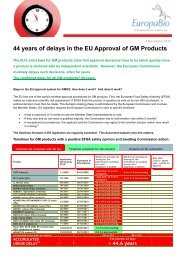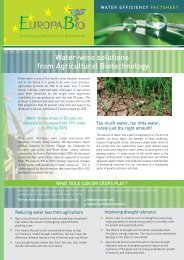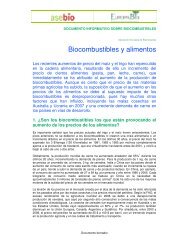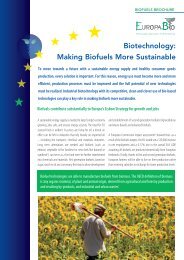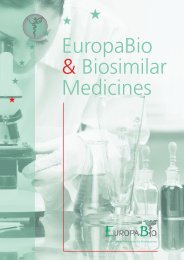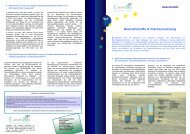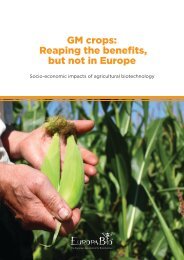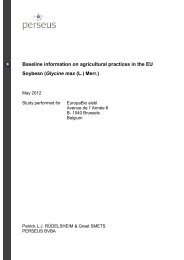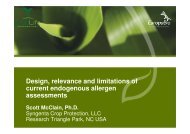Fact Sheet - Europabio
Fact Sheet - Europabio
Fact Sheet - Europabio
You also want an ePaper? Increase the reach of your titles
YUMPU automatically turns print PDFs into web optimized ePapers that Google loves.
MIR604 Maize<br />
Syngenta Agrisure RW Maize<br />
for Corn Rootworm Control<br />
EU approval for import, food and feed use<br />
December 2009
Contents | Maize: an Important Crop 4<br />
Insect-Protected Maize 4<br />
MIR604 Maize: Mode of Action 5<br />
Benefits of MIR604 Maize 6<br />
Safety of MIR604 Maize 9<br />
Human and Animal Safety 10<br />
Environmental Safety 11<br />
Molecular Biology Studies 12<br />
Global Regulatory Status of MIR604 Maize 12<br />
Regulatory Framework for GM Crops in the EU 13<br />
EU Approval of MIR604 Maize 13<br />
Detection Method 15<br />
Traceability, Labelling, Unique Identifier 15<br />
3
Maize: an Important Crop<br />
Maize, also known as corn, is one of the three most important grains in the world. Some 155 million<br />
hectares of maize are harvested annually around the world. 1 Over two-thirds of this is used directly<br />
as animal feed; the rest is used for food, processed food, feed additives and even industrial uses<br />
such as ethanol and starch production. The European Union imports approximately three million<br />
tonnes of maize grain each year. 2<br />
Insect-Protected Maize<br />
Many different insect species feed on maize, including corn borers, earworms, and rootworms.<br />
These pests are estimated to decrease global production by more than 50 million metric tons each<br />
year, with severe economic consequences for growers. As a global leader in agriculture, Syngenta<br />
is committed to developing a range of solutions, including those that utilize biotechnology, to<br />
prevent crop losses from such devastating pests.<br />
Syngenta has developed insect-resistant maize varieties which incorporate a trait event called<br />
MIR604 that has specific activity to corn rootworms and related species, without affecting<br />
non-target organisms. This rootworm-protected maize offers a powerful, convenient and<br />
competitive solution to pest control because it protects the plant from inside the roots, where the<br />
corn rootworms eat.<br />
4<br />
1 USDA 2008 Figures, access August 2009<br />
2 USDA (August 12, 2009, WASDE) and International Grains Council (July 30, 2009) – note: this figure does not include<br />
intra-EU trade
In regions with high levels of infestation, MIR604 maize is an effective tool in integrated pest<br />
management strategies (IPM) and offers growers a safe and environmentally sustainable solution<br />
to control infestations while delivering full yield potential.<br />
MIR604 maize helps farmers improve productivity, secure yields, produce higher quality crops<br />
and reduce the environmental footprint of modern agriculture. Food and feed products made from<br />
MIR604 maize are safe to humans, animals and the environment.<br />
MIR604 Maize: Mode of Action<br />
Event MIR604 (marketed under the brand name Syngenta Agrisure RW) is genetically modified<br />
(GM) maize that expresses a protein which safely and effectively controls corn rootworm<br />
(Coleopteran, Diabrotica sp) infestations. This protein (modified Cry3A or mCry3A), is produced<br />
from the mCry3a gene, a synthetic gene that is related to the cry gene found in the naturallyoccurring<br />
soil bacterium, Bacillus thuringiensis (Bt). The gene is inserted into maize plants using<br />
modern biotechnology techniques and its effect is safe, targeted and reliable. Bt proteins have been<br />
used safely and successfully for insect control for nearly 50 years by farmers and gardeners.<br />
State-of-the-art scientific methods have enabled Syngenta scientists to maximize the production<br />
of mCry3A protein in maize roots, where rootworms feed, while minimizing the presence of the<br />
protein in other parts of the plant, such as the pollen.<br />
Additionally, a marker gene (pmi) has been added to allow the selection of transformed plants<br />
during the research and developmental stage. The pmi gene was isolated from the common<br />
bacterium Escherichia coli. The protein produced by this gene is phosphomannose isomerase<br />
(PMI). PMI allows transformed maize cells to utilize mannose (a simple sugar) as a sole carbon<br />
source, while maize cells lacking PMI cannot grow in this type of media. The PMI protein is<br />
already found naturally in many animal and plant species, and it is a safe selectable marker for<br />
plant transformation.<br />
5
Benefits of MIR604 Maize<br />
MIR604 represents a highly effective way to control the devastating corn rootworm pest, as well as<br />
to secure and increase yields and improve the environmental footprint of modern agriculture.<br />
Corn rootworms are beetles (Coleoptera) from the genus Diabrotica. Western corn rootworm<br />
(WCRW), Diabrotica virgifera virgifera, is a major maize pest in North America. Although not as<br />
widespread, Northern corn rootworm (NCRW), Diabrotica barberi, is also a serious pest for maize<br />
in the USA. Together, these two rootworm species are frequently referred to as “billion dollar<br />
beetles” because the US Department of Agriculture (USDA) estimates that their combined cost to<br />
US corn growers is about $1 billion a year.<br />
In Europe, WCRW is an exotic invasive species. This pest was first observed in 1992 near the city<br />
of Belgrade (former YU) 1 , and since this time it has dispersed in all directions. There have been<br />
outbreaks of this insect near the airports of Venezia (1998) and Milano (2000) in Italy, and near the<br />
airport of Lugano-Agno (2000) in Switzerland as well as Mulhouse airport (2002) in France 2 . WCRW<br />
is currently found in Austria, Bosnia & Herzegovina, Bulgaria, Croatia, Czech Republic, France,<br />
Italy, Germany, Hungary, Romania, Slovakia, Switzerland, and Ukraine. Stringent eradication efforts<br />
are underway.<br />
6<br />
1 Baca et al., 1993<br />
2 EPPO, 2004
How do these insects cause so much damage? The answer relies on two simple factors: location<br />
and number. Adult corn rootworm females lay their eggs in the soil near maize plants. A single<br />
female can lay up to 1000 eggs in her lifetime, so the number of pests present in a crop area can<br />
add up quickly and lead to extensive damage. After hatching, the young rootworms, called larvae,<br />
burrow through the ground to maize roots, where they feed. The larvae eat the fine root hairs<br />
and often burrow into roots. This removal of root tissues affects a plant’s survival by inhibiting its<br />
ability to take up water and soil nutrients. Roots also serve as an important anchoring system, and<br />
damage to them can lead to lodging and what is commonly known as a “goose neck” effect on<br />
the maize stalk.<br />
After several weeks of eating the plant from within, the larvae pupate, or form a cocoon. They<br />
emerge from the cocoon as winged adults, and can fly from one plant to the next, eating maize<br />
silks and pollen, and colonizing nearby fields. Corn rootworms do not have natural enemies in<br />
many areas where they infest maize, and once they move into a field, they can be very difficult to<br />
control. Usually a variety of different methods are needed in order to be effective. Crop rotation<br />
can help in some cases, however, WCRW and NCRW have shown to adapt to rotational control<br />
methods in the US.<br />
Differences in root mass:<br />
control (left); MIR604 maize (right)<br />
7
Event MIR604 maize has been specifically developed to combat attack from corn rootworms.<br />
Because the protection is within the plant’s roots where the corn rootworms feed, it can be<br />
more effective than traditional control methods alone. Combined with other approved Syngenta<br />
insect protection products, such as Cruiser ® seed treatment, chemical insecticides, good farming<br />
practices and integrated pest management systems, Event MIR604 maize will offer growers a full<br />
range of options to protect their maize from corn rootworm damage, and thus help secure and<br />
increase yields in a targeted and sustainable way.<br />
Root rating (0-3 scale)<br />
1.2<br />
1.0<br />
0.8<br />
0.6<br />
0.4<br />
0.2<br />
0.0<br />
Root Damage Ratings<br />
Influence of corn rootworm control method on root rating<br />
Average of 85 trials, 2004-2008<br />
1.16 0.70 0.33 0.23<br />
Untreated check Seed-applied<br />
insecticide<br />
(rootworm rate)<br />
Soil-applied<br />
insecticide<br />
Agrisure® RW<br />
Root ratings based on 0 to 3 root damage scale; 1.0 = one full node of roots pruned.<br />
Source: Syngenta Agronomy Research, Third Party Contractors, and University Cooperators<br />
8
Safety of MIR604 Maize<br />
The safety of Syngenta’s products for humans, animals and the environment is of paramount<br />
importance. Even before any regulatory submissions were made, many years of research have<br />
been conducted with MIR604 maize and the mCry3A protein. MIR604 has been comprehensively<br />
and exhaustively analyzed for human health effects, digestibility, allergenicity and toxicity,<br />
environmental impact, and effects on mammals and non-target organisms. MIR604 has been<br />
assessed and endorsed by numerous independent scientific committees around the world. In all<br />
countries where MIR604 has been approved for food, feed and/or planting, the regulatory authorities<br />
have concluded, after extensive evaluation, that MIR604 maize is as safe as conventional varieties<br />
of maize. These conclusions have been based on a full range of scientific studies, including tests<br />
which examined the potential for human and animal health effects of the product, nutritional<br />
equivalency, the effects of the introduced protein and marker gene, and the potential impacts of<br />
the maize on the environment.<br />
9
Human and Animal Safety<br />
Cry proteins have been used in agriculture for many years and their safety has been<br />
well-established. Studies have been performed to specifically assess the safety of the mCry3A<br />
protein and Event MIR604 maize. Event MIR604 maize has been shown to have nutritional value<br />
equivalent to conventional maize and no adverse effects were observed from human or animal<br />
consumption of Event MIR604 maize, even at high doses.<br />
The allergenicity potential of mCry3A was also assessed. Data indicate that the mCry3A protein,<br />
as expressed in Event MIR604 maize, will be readily digested as conventional dietary proteins. The<br />
mCry3A protein is labile to heat, meaning it is substantially eliminated in food and feed products<br />
by standard processing and cooking methods. The amino acid sequence of the mCry3A protein<br />
was compared to the sequences of known protein toxins and food allergens and it was determined<br />
that there were no similarities suggestive of toxic or allergenic potential for mCry3A. The results<br />
of these, and other, thorough assessments indicate that Event MIR604 maize is as safe as<br />
conventional maize.<br />
Similar studies have been performed with PMI marker, also demonstrating that crops containing<br />
this protein are as safe as conventional crops.<br />
10
Environmental Safety<br />
Environmental risk assessments were conducted on the impacts of Event MIR604 maize for<br />
mammals and non-target organisms, such as birds, fish, earthworms, honeybees, ladybird beetles<br />
(ladybugs), soil beetles, and insects. These assessments, as well as numerous studies published<br />
by independent scientists, show MIR604 maize to be as safe as conventional maize.<br />
Data demonstrate that mCry3A has specific activity toward the target pest insects, and that it<br />
does not have activity against other non-target organisms. This specific activity occurs because<br />
there are several barriers that must be overcome in order to make the mCry3A protein work:<br />
first, the target organism must feed on maize tissue containing the mCry3A protein. Second, once<br />
the mCry3A protein is ingested, the gut pH must be just right so that the protein is made soluble.<br />
Third, the right combination of gut digestive enzymes (proteases) must be present in order to<br />
process mCry3A to its smaller, active form. The modification in the mCry3A protein allows it to be<br />
activated by specific proteases in the corn rootworm’s gut, leading to improper salt balance and<br />
ultimately starvation. If any step in the process is missing, then the protein simply cannot perform<br />
its function. Because living organisms are so complex, only very specific target organisms have<br />
exactly the right combination of characteristics for mCry3A to be effective.<br />
11
Molecular Biology Studies<br />
Thorough studies have been undertaken to demonstrate that the inserted mcry3A gene is expressed<br />
as intended, and that the level of mCry3A protein is appropriate to have the desired effect on the<br />
corn rootworms. The data demonstrate that the mCry3A protein is not detectable in the pollen of<br />
Event MIR604 maize plants, and that the expression levels and CRW activity are stable across<br />
many generations. Similar studies have been performed with PMI, also demonstrating that crops<br />
containing this protein are as safe as conventional maize.<br />
Global Regulatory Status of MIR604 Maize<br />
Syngenta’s Agrisure ® RW now has full food, feed and environmental approval in the United States,<br />
Canada, and Japan, and import approval in Mexico, Taiwan, Korea, China, Philippines, Russia,<br />
Australia, New Zealand.<br />
With the EU approval for food, feed and import, Agrisure ® RW grain can now be accepted by<br />
elevators exporting grain to the EU.<br />
12
Regulatory Framework for GM Crops in the EU<br />
The EU has in place strict legislation covering GM food, feed and crops, including Directive<br />
2001/18/EC for deliberate release of GMOs into the environment (repealing Directive 90/220/EEC)<br />
and Regulation (EC) No. 1829/2003 on GM food and feed. Additionally, the labeling and traceability<br />
Regulation (EC) 1830/2003 for GM food and feed requires labeling for food and feed containing<br />
GM material above 0.9%.<br />
EU Approval of MIR604 for Food and Feed Imports<br />
On 23 December 2004, Syngenta Seeds S.A.S. on behalf of Syngenta Crop Protection AG,<br />
submitted an application to the competent authority of the United Kingdom for the import approval<br />
of MIR604 maize, in accordance with Articles 5 and 17 of Regulation (EC) No. 1829/2003, for the<br />
placing on the market of foods, food ingredients, and feed containing, consisting of, or produced<br />
from MIR604 maize. The application also covers the placing on the market of other products<br />
containing or consisting of MIR604 maize for the same uses as any other maize with the exception<br />
of cultivation. The application also includes a monitoring plan for environmental effects conforming<br />
with Annex VII to Directive 2001/18/EC consisting of a general surveillance plan, in line with the<br />
intended use of the products.<br />
13
On 21July 2009, the European Food Safety Authority (EFSA) gave a positive opinion in accordance<br />
with Articles 6 and 18 of Regulation (EC) No. 1829/2003 and concluded that it is unlikely that the<br />
placing on the market of the products containing, consisting of, or produced from MIR604 maize<br />
will have any adverse effects on human or animal health or the environment in the context of their<br />
intended uses 1 .<br />
In addition, the EFSA opinion states:<br />
“There are no indications of an increased likelihood of establishment or survival of feral<br />
maize plants in case of accidental release into the environment of maize MIR604 viable<br />
grains during transportation and processing for food and feed uses. Taking into account<br />
the scope of the application, both the rare occurrence of feral plants and the low levels of<br />
exposure through other routes indicate that the risk to non-target organisms is negligible.”<br />
After consideration by the Standing Committee on the Food Chain and Animal Health (SCFCAH)<br />
on 19 October 2009, and the Council of Agriculture Ministers on 20 November 2009, MIR604<br />
was approved by the European Commission on 30 November 2009 for food, feed, import and<br />
processing in accordance with Regulation (EC) No. 1829/2003 on GM food and feed (Commission<br />
Decision of 30 November 2009 authorising the placing on the market of products containing,<br />
consisting of, or produced from genetically modified maize MIR604 (SYN-IR6Ø4-5) pursuant to<br />
Regulation (EC) No. 1829/2003 of the European Parliament and of the Council 2 ) which adopted the<br />
proposals for 10 years authorisation.<br />
14<br />
1 http://www.efsa.europa.eu/EFSA/efsa_locale-1178620753812_1211902691168.htm<br />
2 http://eur-lex.europa.eu/LexUriServ/LexUriServ.do?uri=OJ:L:2009:314:0102:0105:EN:PDF
Detection Method<br />
An event-specific method for the quantification of MIR604 using real-time PCR has been validated<br />
by the European Commission Joint Research Centre (JRC). It was published on the Community<br />
Reference Laboratory (CRL) website on 3 April 2007 3 .<br />
Reference Material (ERM ® -BF423) is accessible at the Institute of Reference Materials and<br />
Measurements (IRMM) 4 .<br />
Traceability, Labelling, Unique Identifier<br />
Operators importing, handling or using MIR604 grain and derived foods and feeds in the EU are<br />
informed of the legal obligations regarding traceability and labelling, laid down in Regulation (EC)<br />
No. 1830/2003 and in the conditions of placing on the market of the consent.<br />
No specific labelling requirements other than those provided for in Articles 13 (1) and 25 (2) of Regulation<br />
(EC) No. 1829/2003 are necessary for foods, food ingredients and feed containing, consisting of,<br />
or produced from MIR604 maize. However, in order to ensure the use of the products within the<br />
limits of the authorisation, the Commission Decision request that the words ‘not for cultivation’<br />
shall appear on the label of and in documents accompanying products containing or consisting of<br />
MIR604 maize. The unique identifier of MIR604 is SYN-IR6Ø4-5.<br />
3 http://gmo-crl.jrc.ec.europa.eu/statusofdoss.htm<br />
4 http://www.irmm.jrc.be/html/reference_materials_catalogue/index.htm<br />
15
Syngenta International AG<br />
P.O. Box<br />
CH-4002 Basel<br />
Switzerland<br />
www.syngenta.com



